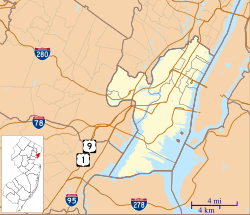
Hudson County is the smallest and most densely populated county in the U.S. state of New Jersey. It lies west of the lower Hudson River, which was named for Henry Hudson, the sea captain who explored the area in 1609. Part of New Jersey's Gateway Region in the New York metropolitan area, the county seat is Jersey City, which is the county's largest city in terms of both population and area.
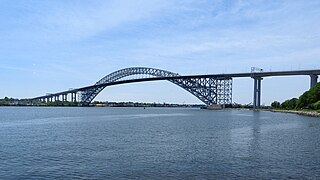
Bayonne is a city in Hudson County in the U.S. state of New Jersey. Located in the Gateway Region, Bayonne is situated on a peninsula between Newark Bay to the west, the Kill Van Kull to the south, and New York Bay to the east. As of the 2020 United States census, the city was the state's 15th-most-populous municipality, surpassing 2010 #15 Passaic, with a population of 71,686, an increase of 8,662 (+13.7%) from the 2010 census count of 63,024, which in turn reflected an increase of 1,182 (+1.9%) from the 61,842 counted in the 2000 census. The Census Bureau's Population Estimates Program calculated that the city's population was 69,527 in 2022, ranking the city the 543rd-most-populous in the country.

The Central Railroad of New Jersey Terminal, also known as Communipaw Terminal and Jersey City Terminal, was the Central Railroad of New Jersey's waterfront passenger terminal in Jersey City, New Jersey. The terminal was built in 1889, replacing an earlier one that had been in use since 1864. It operated until April 30, 1967.

The Robbins Reef Light Station is a sparkplug lighthouse located off Constable Hook in Bayonne, Hudson County, New Jersey, United States, along the west side of Main Channel, Upper New York Bay. The tower and integral keepers quarters were built in 1883. It replaced an octagonal granite tower built in 1839. The U.S. Coast Guard owned and operated the light station until the 2000s.

The Hudson River Waterfront Walkway, also known as the Hudson River Walkway, is a promenade along the Hudson Waterfront in New Jersey. The ongoing and incomplete project located on Kill van Kull and the western shore of Upper New York Bay and the Hudson River was implemented as part of a New Jersey state-mandated master plan to connect the municipalities from the Bayonne Bridge to the George Washington Bridge with an urban linear park and provide contiguous unhindered access to the water's edge.

Rutherford is a New Jersey Transit railroad station served by the Bergen County Line located in Rutherford, New Jersey, United States. The station is located near a traffic circle at the junction of Park Avenue, Union Avenue, Erie Avenue and Orient Way known as Station Square, with a grade crossing on Park Avenue.
Whitney House or Whitney Mansion may refer to:

The Old Bergen Church is a historic church congregation in Jersey City, Hudson County, New Jersey, United States. Established in 1660 in what was then the Dutch colony of New Netherland, it is the oldest continuous religious congregation in what is today the State of New Jersey. The congregation is jointly affiliated with the Reformed Church in America and the Presbyterian Church (USA). The church was added to the National Register of Historic Places on August 14, 1973. The original church building was constructed in 1680 and the current edifice was built in 1841.

The Grace Church Van Vorst, is located in Jersey City, Hudson County, New Jersey, United States. The church was added to the National Register of Historic Places on August 1, 1979. The church was built in 1853 and was named after the former Van Vorst Township. The church is an English Gothic-style Episcopal church which was designed by Detlef Lienau. The building is constructed with brownstone and has a slate roof. The church was expanded in 1864 with the addition of two bays to the west and a baptistry added midway on the south side of the building. The 57-foot high square tower was added in 1912. Adjacent to the church is a rectory that was also designed by Lienau in a similar style to the church.

The Dr. William Barrow Mansion is located at 83 Wayne Street between Barrow Street and Jersey Avenue in Downtown Jersey City, Hudson County, New Jersey, United States. The mansion was added to the National Register of Historic Places on May 2, 1977, and is located within the Van Vorst Park Historic District, which itself was dedicated on March 5, 1980, and is roughly bounded by Railroad Avenue, and Henderson, Grand, Bright, and Monmouth Streets.

The Fairmount Apartments, also known as the Grand Lady of Jersey City, are located in Jersey City, Hudson County, New Jersey, United States. The Apartments were added to the National Register of Historic Places on March 3, 1995. The Apartments are an example of an early twentieth century Arts and Crafts style apartments. The building consists of two L-shaped 4+1⁄2-story brick-and-concrete structures connected by a 1-story structure.
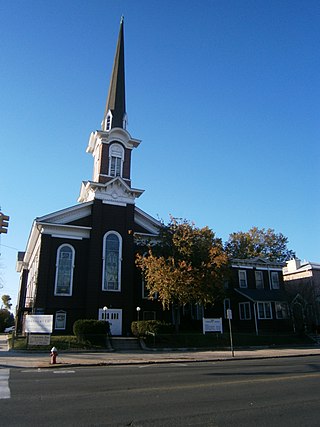
The First Reformed Dutch Church of Bergen Neck, now known as The First Federated Church of Bayonne is located in Bayonne, Hudson County, New Jersey, United States. The church was added to the National Register of Historic Places on April 22, 1982.

The Jersey City YMCA, is located in Bergen Section of Jersey City, Hudson County, New Jersey, United States. The YMCA building was added to the National Register of Historic Places on November 12, 1999. The building is an example of an early twentieth century Renaissance Revival style. Built in 1923, in 1995 the building ceased to be used by the YMCA and was converted into affordable housing.
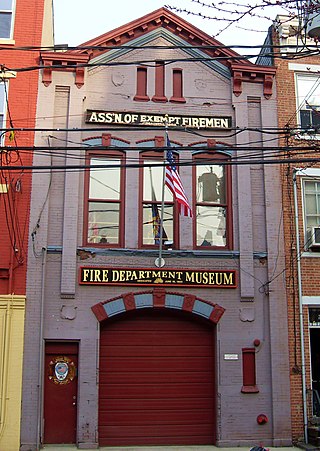
The Association of Exempt Firemen Building is located in Hoboken, Hudson County, New Jersey, United States. The building was designed by Francis G. Himpler and was built in 1870. The building was added to the National Register of Historic Places on March 30, 1984 as Assembly of Exempt Firemen Building. The building serves as a firefighters' union hall and as a museum of Hoboken firefighters' memorabilia, the Hoboken Fire Department Museum.
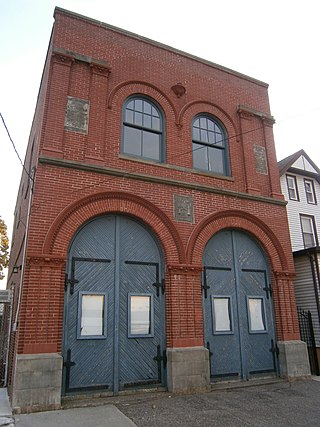
Highland Hose No. 4 is located in Kearny, Hudson County, New Jersey, United States. The firehouse was added to the National Register of Historic Places on May 29, 1987. The firehouse was constructed in 1894 to be used by Highland Hose No. 4. The firehouse is currently used as a meeting hall for the Firemen's Mutual Benevolent Association. Locals refer to the building as "The Exempts".

Bayonne Truck House No. 1, also known as Chief John T. Brennan Fire Museum, is located in Bayonne, Hudson County, New Jersey, United States. The firehouse was added to the National Register of Historic Places on January 2, 1976. The firehouse was constructed in 1875 to be used by Bayonne Hook and Ladder Company #1. The firehouse is now a museum known as the John T. Brennan Fire Museum.

The Bayonne Community Museum is located in the Bergen Point section of Bayonne, Hudson County, New Jersey, United States.

Ficken's Warehouse, is located in Bergen Hill, Jersey City, Hudson County, New Jersey, United States. The building was added to the National Register of Historic Places on June 14, 1984. The building was built in 1910 by John H. Fickens and used as a stable and warehouse. The building was later used as the Bergen Station Post Office for 50 years before being converted to residential use.

The Bergen Section of Jersey City, New Jersey is the neighborhood on either side of Kennedy Boulevard between Saint Peter's College/ McGinley Square and Communipaw Avenue in the Bergen-Lafayette section of the city. The name Bergen, used throughout Hudson County, is taken from the original Bergen, New Netherland settlement at Bergen Square.
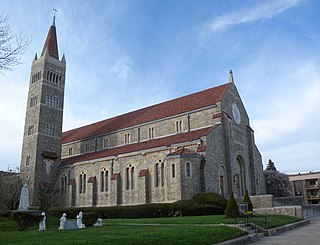
St. Vincent de Paul Catholic Church is located in Bayonne, Hudson County, New Jersey, United States. It is an active parish of the Archdiocese of Newark, in Deanery 13. It is noted for its historic parish church, which was added to the National Register of Historic Places on August 24, 2011, for its significance in architecture and art.

